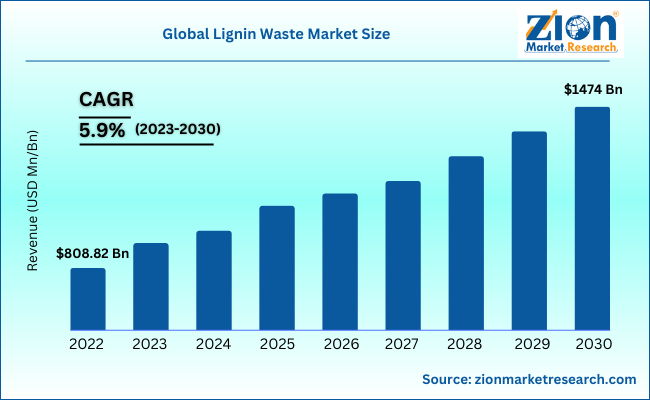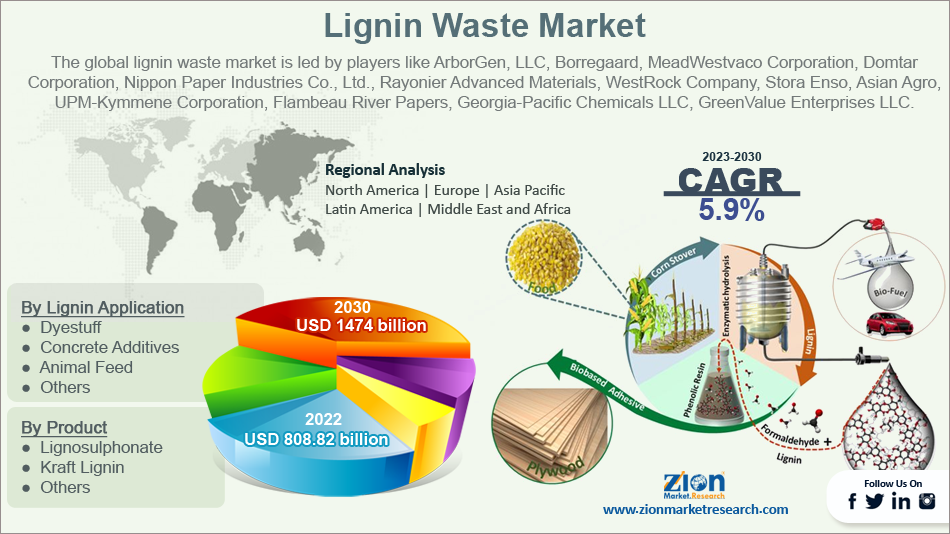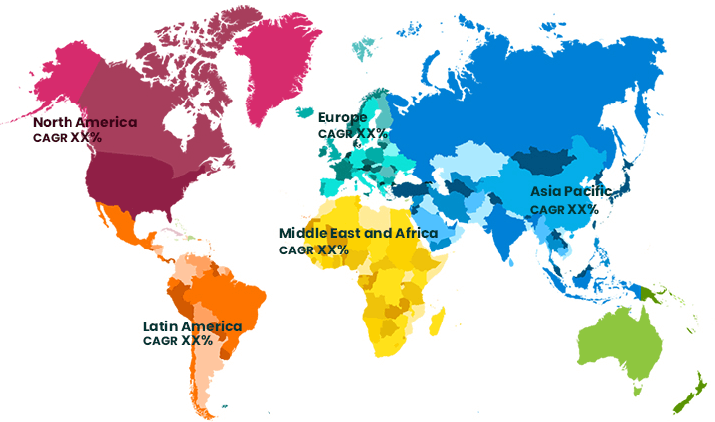Lignin Waste Market Size, Share, Trends, Growth 2030

Lignin Waste Market By Lignin Application (Dyestuff, Concrete Additives, Animal Feed, and Others), By Product (Lignosulphonate, Kraft Lignin, and Others), and By Region - Global and Regional Industry Overview, Market Intelligence, Comprehensive Analysis, Historical Data, and Forecasts 2023 - 2030
| Market Size in 2022 | Market Forecast in 2030 | CAGR (in %) | Base Year |
|---|---|---|---|
| USD 808.82 Billion | USD 1474 Billion | 5.9% | 2022 |
Lignin Waste Industry Prospective:
The global lignin waste market size was worth around USD 808.82 Billion in 2022 and is predicted to grow to around USD 1474 Billion by 2030 with a compound annual growth rate (CAGR) of roughly 5.9% between 2023 and 2030.
The report analyzes the global lignin waste market drivers, restraints/challenges, and the effect they have on the demands during the projection period. In addition, the report explores emerging opportunities in the lignin waste industry.
Lignin Waste Market: Overview
Lignin waste is a commonly found byproduct in the pulp and paper sector. It is generated during the production of paper or other wood-based products. Lignin is an extremely complex organic polymer that is used to bind cellulose fibers in plants and trees as a unit. During the production of paper, wood is processed to produce pulp. During this protocol, the removal of lining from cellulose fibers is the crucial step post which the compound is either discarded as waste or burned for energy generation. In the last few years, there has been significant growth in terms of interest in using lignin waste for further applications, especially as sustainable and renewable raw materials for other applications, such as chemicals, biofuels, and materials. The waste can be efficiently converted into high-grade products through different processes like hydrolysis, pyrolysis, and other types of enzyme-based treatments. The fraternity is expected to grow steadily during the forecast period due to the rising investments toward better research & development of the byproduct.
Key Insights:
- As per the analysis shared by our research analyst, the global lignin waste market is estimated to grow annually at a CAGR of around 5.9% over the forecast period (2023-2030)
- In terms of revenue, the global lignin waste market size was valued at around USD 808.82 billion in 2022 and is projected to reach USD 1474 billion, by 2030.
- The lignin waste market is projected to grow at a significant rate due to the growing demand for renewable raw materials
- Based on application segmentation, concrete additives were predicted to show maximum market share in the year 2022
- Based on product segmentation, lignosulphonate was the leading user in 2022
- On the basis of region, North America was the leading revenue generator in 2022
Lignin Waste Market: Growth Drivers
Increasing demand for renewable raw materials to promote market growth
With the growing awareness around the negative environmental impact of urbanization, commercialization, and industrialization, end-consumers are increasing advertising toward adopting renewable sources of energy for meeting their requirements and demand. As the world becomes more aware of the consequences of consuming non-renewable sources, the global lignin waste market can expect higher growth since the demand for sustainable raw materials is growing at a rapid rate. Lignin waste, which is a byproduct of the growing pulp and paper industry, is considered a potential replacement for non-renewable raw materials in the chemicals and materials sector.
In addition to this, the rising focus on circular economies across the world could create higher revenue during the forecast period. This type of economy promotes minimizing waste and maximizing resource efficiency. The use of lignin waste is a crucial step in achieving this vision.
Lignin Waste Market: Restraints
High cost of the extraction process to restrict market expansion
The process of extracting lignin from wood pulp is a complex process and necessitates the need for high capital investment along with intensive sources. This can act as a significant barrier against growth, especially for small or new players who may be working on limited budgets or may be unable to view economic viability in the lignin waste industry. In addition to this, the absence of standardization protocols can result in variation in terms of the quality of the waste. This is because of the heterogeneous structure of the compound making it difficult to standardize the extraction process.
Lignin Waste Market: Opportunities
Growing investment toward the development of new applications to promote further growth
Lignin waste can be efficiently converted into a wide range of products, including biofuels, chemicals, and materials. The growing investments toward the development of new applications for the compound for instance in the construction industry, one of the fastest-growing sectors, can create new opportunities for lignin utilization. Furthermore, the advancements in technology are expected to work in the favor of the lignin waste industry players. This included processes involved in the extraction and valorization of lignin waste. The most lucrative segment may be the use of waste to improve carbon fiber performance.
Lignin Waste Market: Challenges
High competition from alternatives to challenge market growth
The global lignin waste market faces high competition from other substitutes in terms of renewable and sustainable raw materials. Some examples of alternatives are cellulose and hemicellulose. Additionally, the world is currently heavily reliant on non-renewable materials like petrochemicals acting as a major energy resource. The high competition can limit the demand for lignin waste and make it difficult for lignin-based products to compete in the market.
Lignin Waste Market: Segmentation
The global lignin waste market is segmented based on application, product, and others.
Based on application, the global market segments are dyestuff, concrete additives, animal feed, and others. The industry witnessed the highest growth in the concrete additives segment in 2022 followed by animal feed applications. Properties of lignin waste like water reduction, setting time control, and increased strength are major reasons why the compound is used extensively as a concrete additive. Furthermore, it is also considered a more eco-friendly and sustainable product as compared to other materials. In the animal feed segment, it is used as a source of fiber and energy for animals. As the demand for organic and healthy animal feed is on the rise, the segment can expect a higher CAGR. When wood is used as a raw material to produce waste, lignin forms around 20-30% of the wood by weight.
Based on product, the global market is divided into lignosulphonate, kraft lignin, and others. The industry is dominated by the lignosulphonate segment since it is widely used as emulsifiers, binders, and dispersants and has various end-vertical applications, such as animal feed, agriculture, and construction. It is a water-soluble derivative of lignin waste and is produced during the sulfite pulping process for producing paper from wood. Kraft lignin is produced during the kraft pulping process and although the properties are similar to lignosulphonate, kraft lignin is not water-soluble. On average, lignosulfonates make up about 5-10% of the total sulfite pulping liquor by weight.
Recent Developments:
- In July 2021, Oak Ridge National Laboratory’s scientific community announced the discovery of a new microbial enzyme that can effectively degrade the otherwise tough-to-break bonds found in lignin. This discovery can assist in the production of less expensive bioproducts and biofuels
- In September 2022, MetGen Oy and Technip Energies announced a joint collaboration that will work toward the industrialization of METNIN technology which is used for lignin valorization. METNIN is an enzyme-based product that caused lignin fragmentation from lignocellulosic feedstocks
Lignin Waste Market: Report Scope
| Report Attributes | Report Details |
|---|---|
| Report Name | Lignin Waste Market Research Report |
| Market Size in 2022 | USD 808.82 Billion |
| Market Forecast in 2030 | USD 1474 Billion |
| Growth Rate | CAGR of 5.9% |
| Number of Pages | 220 |
| Key Companies Covered | ArborGen, LLC, Borregaard, MeadWestvaco Corporation, Domtar Corporation, Nippon Paper Industries Co., Ltd., Rayonier Advanced Materials, WestRock Company, Stora Enso, Asian Agro, UPM-Kymmene Corporation, Flambeau River Papers, Georgia-Pacific Chemicals LLC, GreenValue Enterprises LLC, Dallas Group of America, Inc., Domsjö Fabriker AB, Changzhou Shanfeng Chemical Industry Co., Ltd., Lignin Institute LLC, The Dallas Group of America, Inc., Northway Mushrooms, Tembec Inc., Renewable Energy Group, Inc., Southland Organics, and Suzano S.A. |
| Segments Covered | By Lignin Application, By Product, And By Region |
| Regions Covered | North America, Europe, Asia Pacific (APAC), Latin America, Middle East, and Africa (MEA) |
| Base Year | 2022 |
| Historical Year | 2017 to 2021 |
| Forecast Year | 2023 - 2030 |
| Customization Scope | Avail customized purchase options to meet your exact research needs. Request For Customization |
Lignin Waste Market: Regional Analysis
North America to grow at the highest CAGR
The global lignin waste market is expected to witness the highest growth in North America where Canada and the US are anticipated to act as key revenue generators. The presence of an expansive pulp and paper industry in these regions is crucial to a higher production rate of lignin waste.
In addition to this, the rising focus on switching to renewable sources of energy encouraged by various government initiatives and the proactive approach of the end-consumers are important for regional CAGR. In Europe, Nordic countries along with France and Germany are expected to lead the regional revenue due to growing demand for lignin waste in the construction sector along with use as animal feed. The Asia-Pacific region is registering a high rate of interest in the development of efficient processes for lignin waste valorization. This is more evident in China and India which are expected to register high energy demand in the coming years.
Lignin Waste Market: Competitive Analysis
The global lignin waste market is led by players like:
- ArborGen LLC
- Borregaard
- MeadWestvaco Corporation
- Domtar Corporation
- Nippon Paper Industries Co. Ltd.
- Rayonier Advanced Materials
- WestRock Company
- Stora Enso
- Asian Agro
- UPM-Kymmene Corporation
- Flambeau River Papers
- Georgia-Pacific Chemicals LLC
- GreenValue Enterprises LLC
- Dallas Group of America Inc.
- Domsjö Fabriker AB
- Changzhou Shanfeng Chemical Industry Co. Ltd.
- Lignin Institute LLC
- The Dallas Group of America Inc.
- Northway Mushrooms
- Tembec Inc.
- Renewable Energy Group Inc.
- Southland Organics
- Suzano S.A.
The global lignin waste market is segmented as follows:
By Lignin Application
- Dyestuff
- Concrete Additives
- Animal Feed
- Others
By Product
- Lignosulphonate
- Kraft Lignin
- Others
By Region
- North America
- The U.S.
- Canada
- Europe
- France
- The UK
- Spain
- Germany
- Italy
- Rest of Europe
- Asia Pacific
- China
- Japan
- India
- South Korea
- Southeast Asia
- Rest of Asia Pacific
- Latin America
- Brazil
- Mexico
- Rest of Latin America
- Middle East & Africa
- GCC
- South Africa
- Rest of Middle East & Africa
Table Of Content
Methodology
FrequentlyAsked Questions
Lignin waste is a commonly found byproduct in the pulp and paper sector. It is generated during the production of paper or other wood-based products.
As the world becomes more aware of the consequences of consuming non-renewable sources, the global lignin waste market can expect higher growth since the demand for sustainable raw materials is growing at a rapid rate.
According to study, the global lignin waste market size was worth around USD 808.82 billion in 2022 and is predicted to grow to around USD 1474 billion by 2030.
The CAGR value of lignin waste market is expected to be around 5.9% during 2023-2030.
The global lignin waste market is expected to witness the highest growth in North America where Canada and the US are anticipated to act as key revenue generators.
The global lignin waste market is led by players like ArborGen, LLC, Borregaard, MeadWestvaco Corporation, Domtar Corporation, Nippon Paper Industries Co., Ltd., Rayonier Advanced Materials, WestRock Company, Stora Enso, Asian Agro, UPM-Kymmene Corporation, Flambeau River Papers, Georgia-Pacific Chemicals LLC, GreenValue Enterprises LLC, Dallas Group of America, Inc., Domsjö Fabriker AB, Changzhou Shanfeng Chemical Industry Co., Ltd., Lignin Institute LLC, The Dallas Group of America, Inc., Northway Mushrooms, Tembec Inc., Renewable Energy Group, Inc., Southland Organics, and Suzano S.A.
HappyClients
Zion Market Research
Tel: +1 (302) 444-0166
USA/Canada Toll Free No.+1 (855) 465-4651
3rd Floor,
Mrunal Paradise, Opp Maharaja Hotel,
Pimple Gurav, Pune 411061,
Maharashtra, India
Phone No +91 7768 006 007, +91 7768 006 008
US OFFICE NO +1 (302) 444-0166
US/CAN TOLL FREE +1 (855) 465-4651
Email: sales@zionmarketresearch.com
We have secured system to process your transaction.
Our support available to help you 24 hours a day, five days a week.
Monday - Friday: 9AM - 6PM
Saturday - Sunday: Closed








